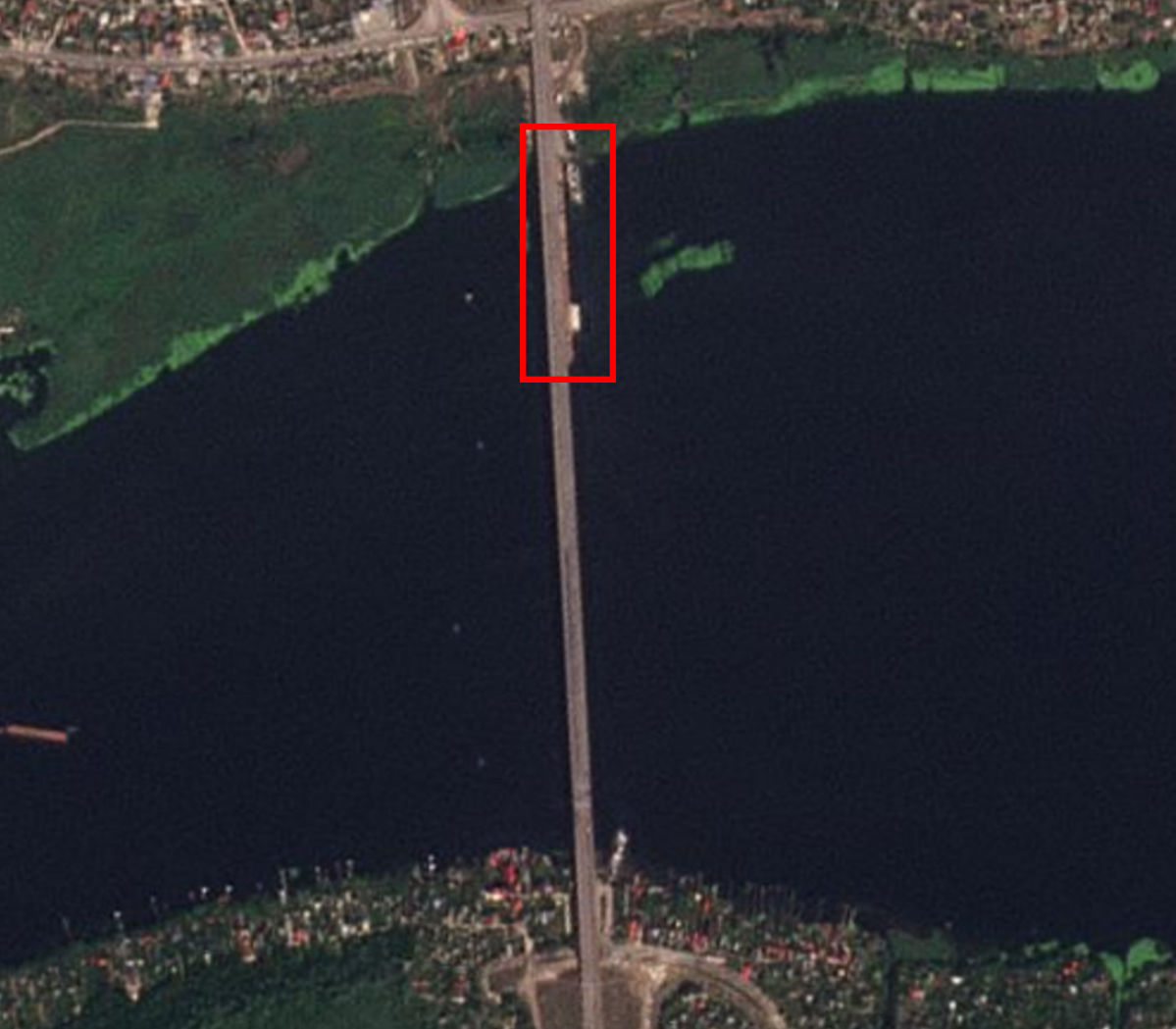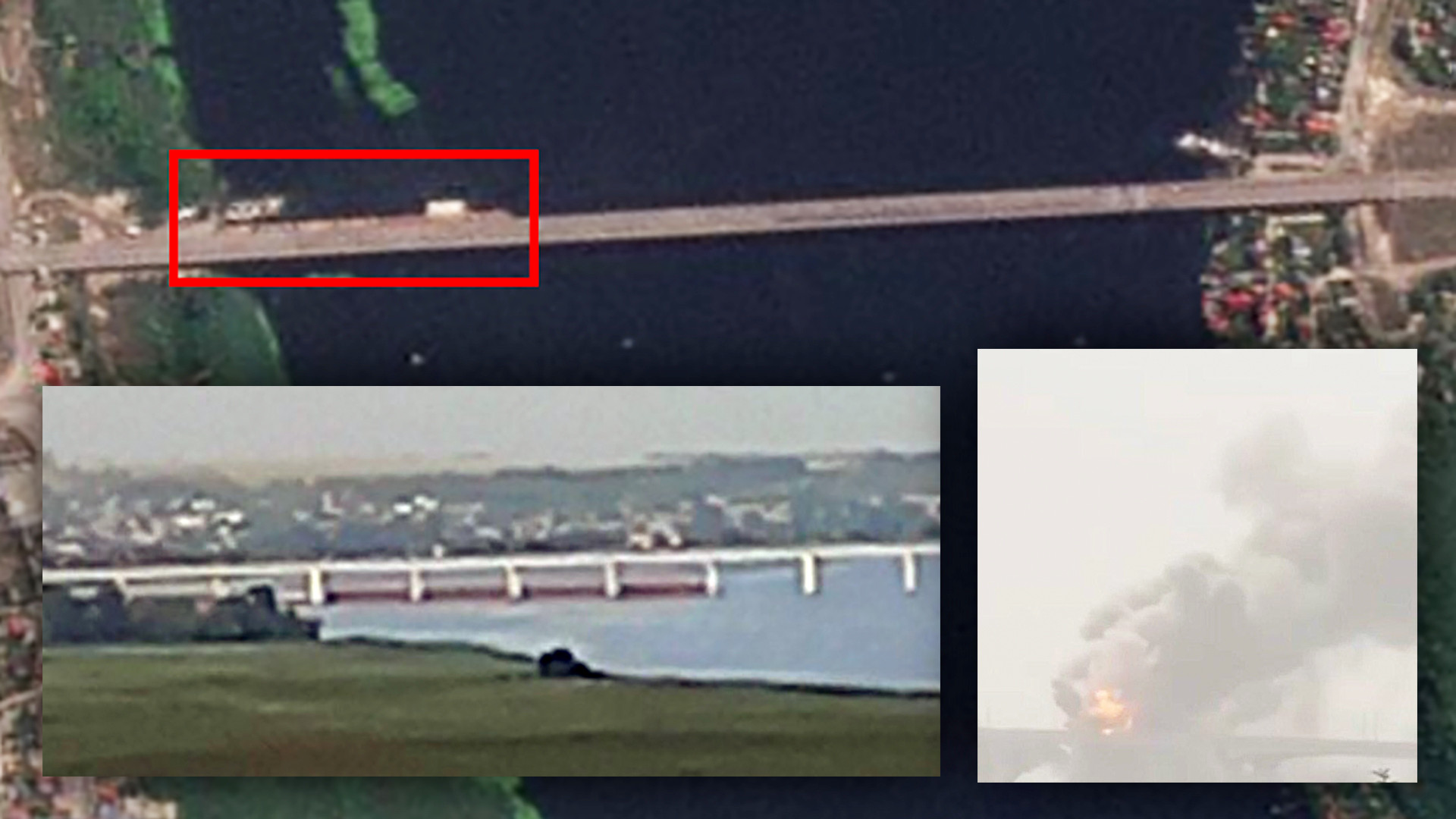Ukrainian forces again trained their U.S.-donated High Mobility Artillery Rocket Systems, or HIMARS, on the Antonvsky Bridge over the Dnipro River, Russia’s primary logistical link to the occupied Kherson. After as many as seven previous strikes, and despite attempts to repair it, the span remains damaged to the point that Russian forces appear to be trying to construct a pontoon bridge across the river to reestablish a steady flow of supplies and personnel.
An August 22 map of the frontline from the U.K. Ministry of Defense shows Ukraine’s push southward toward Kherson, putting more logistical pressure on Russian Army forces arrayed north of the river.
A spokesperson for Ukraine’s Armed Forces said Russian forces are constantly attempting to repair the damage.
Locals in the occupied city of Kherson also reported the bridge was badly damaged in additional strikes, possibly aided by the secondary explosions of Russian ammunition trucks that were trying to cross the bridge when it was hit. Photos of a large explosion near the bridge then began circulating online. It’s not clear if the bridge was hit or the ferry and/or pontoon barge beside it was.
Even Russia’s state-sponsored TASS media outlet confirmed the latest attack on the bridge, saying at least 15 people were injured in the strike. The Russian outlet quoted a spokesman for local emergency services as saying that civilian repairmen were the only people on the bridge when the incoming weapons hit. The bridge has been closed to civilians for more than a month.
“At about 13:00 on August 22, Ukrainian troops delivered a strike from US-made HIMARS rocket systems at the Antonovka Bridge to break down repair works,” TASS quoted the spokesman as saying. “At least 15 people (civilian employees of the local repair team) were hurt as a result of Ukraine’s aggression. There were no casualties among people providing ferryboat services and those on the ferry.”
TASS asserted the bridge was attacked five times in July and that this was the third time in August that Ukrainian ordnance had struck the span.
Keeping the bridge, and two others upriver, in an unusable state effectively strangles Russian forces north of the Dnipro (Dnieper) River, keeping them from a constant, high-volume flow of resupplies from forces on the southern bank in Kherson and farther south in Crimea.
A previous series of strikes on the bridge inspired Russia to both attempt repairs of the elevated roadway and to launch a ferry service across the Dnipro into Kherson city.
Satellite images and photos of the bridge from Planet Labs now suggest Russian forces are attempting to assemble a pontoon bridge directly adjacent to the permanent span.

Barges and other elements of a potential pontoon bridge have also been photographed very near, if not almost partially under the existing span, which could help protect it from future HIMARS strikes. The pontoon bridge that sits just to the east side of the main bridge has been growing over the past couple of days, and it seems clear that Russia looks to reach the other side of the river with it. If not, it could be used as an expanded dock so that more ferries can be loaded, although we don’t see a corresponding installation on the north bank, so this is unlikely.
Russian forces also have attempted to protect vital bridges with arrays of pyramidal radar reflectors in the water near the spans, although the crude countermeasures have no impact on HIMARS’ guided rockets and would have questionable utility against any guided missile.
Russian forces have struggled with the river network in eastern Ukraine since early in the war. Recognizing the invading army’s apparent incompetence at crossing waterways, the Ukrainians have targeted strategic bridges in an attempt to cut enemy supply lines and deny opposition forces an escape route to occupied regions towards their rear.
The Kerch Strait Bridge — actually a pair of parallel spans, one each for road traffic and rail — linking Crimea with Russia is out of range for Ukraine’s HIMARS systems, which can reach about 43 miles. That span, which serves as a logistical superhighway for military and civilian logistics into the peninsula Moscow annexed in 2014, is a desirable target and the U.S. has deemed it a fair one. Ukraine’s Ministry of Defense on Aug. 22 posted a gag video Monday showing a HIMARS approaching the bridges’ truss arches on what appears to be an inflatable backyard swimming pool.
The clip drives home the notion that Ukraine has its sights on Russia’s supply arteries, including its prized $3.5 billion Kerch Strait Bridge.
Still, Russia is aware of how far Ukrainian weapons can reach, as evidenced by the devastating attack on its Saki Air Base in Crimea last week and continued explosions elsewhere, at least some due to shadowy long-range suicide drones. Although, it takes heavy pinpoint weaponry not just to destroy a bridge span but to even damage it enough for it to be put out of action for a relatively short period of time. Drones really aren’t ideal for this application.
Before we dive into the bulk of what’s happened in Ukraine over the past 48 hours, be sure to take a moment to catch up on our previous rolling coverage here.
The Latest
Ukraine’s most senior military official puts the number of Ukrainian troops killed since Russia’s all-out invasion began in February at about 9,000. Gen. Valeriy Zaluzhnyi gave the assessment, the first official combat death toll given by senior Ukrainian military officials.
That is a heavy toll in six months of fighting, a milestone that coincides with Ukrainian Independence Day on August 24. Moscow is rumored to be massing weaponry and possibly troops in Belarus and strengthening its Black Sea Fleet to mark the occasion, perhaps to execute massive coordinated missile strikes via ground launchers and naval vessels.
In line with these reports, the U.S. State Department issued a warning saying that it “has information that Russia is stepping up efforts to launch strikes against Ukraine’s civilian infrastructure and government facilities in the coming days.” The alert advises U.S. citizens to the leave country and recommends using “privately available ground transportation options if it is safe to do so.”
In another reminder that Russian weapons still indiscriminately threaten Ukrainian cities, more footage has surfaced of falling phosphorous or thermite incendiary weapons, cascading onto Marinka, west of Donetsk. Possibly from an attack last May with the white-hot burning substance, the video appears to be filmed from the broken arch-shaped window of a church that has since been geolocated.
The Ukrainian MoD confirmed that the Bayraktar TB2 drone crowdfunded by Lithuanians and subsequently donated by Turkish manufacturer Baykar has scored its first kill. That particular TB2, nicknamed “Vanagas” or “Hawk” in Lithuanian, was delivered in early July. Video of the drones taking out Russian armored vehicles suggests they are still being deployed in an offensive role and not only relegated to reconnaissance missions.
As iconic and beloved as the TB2 has become for its effectiveness against Russian combat vehicles, naval vessels, and other equipment, the Bayraktar is not immune to enemy air defenses. This is especially so as the front lines in the east became better reinforced and air defense systems were pushed increasingly forward and bedded-down. Russian forces posted images of the pieces of one TB2 it recently shot down.
Ukrainian forces continue to take a toll on Russian unmanned aerial vehicles, as well. They recently brought down another Russian Orlan-10 in eastern Ukraine. Images of the largely intact wreckage suggest the drone was downed by electronic warfare (EW) means rather than by a surface-to-air missile system.
Ukrainian forces also claim to have downed an Eleron-3 light reconnaissance UAV using a similar sort of EW system.
That EW system could be the Drone Defender, made by Dedrone and almost certainly donated by the United States or its NATO allies. Photos of the vaguely rifle-shaped anti-drone weapon held by Ukrainian troops appeared online recently.
Ukraine’s military is also proudly showcasing its surviving surface-to-air missile (SAM) capabilities. The Ukrainian Air Force claims to have shot down seven drones, a pair of Kalibr cruise missiles, and a Ka-52 attack helicopter on April 21 alone.
A slick video recently popped up online showing Ukrainian Air Force personnel preparing the S-125M SAM system (SA-3), as well as an R-73 air-to-air missile for use on Ukrainian fighter aircraft.
In yet another bizarre episode on the war’s periphery, Russian officials and state media are flailing to explain the assassination of Darya Dugina, the daughter of virulent anti-Ukraine philosopher and Vladimir Putin associate Alexander Dugin. Dugina was killed in what appears to be a targeted car bombing on the outskirts of Moscow on Monday.
Dugin released a statement Monday on the killing of his daughter blaming Ukraine and calling for the country’s destruction, which he has prominently advocated since the war began.
For its part, the FSB launched a murder investigation and almost immediately — suspiciously quickly — pronounced the case solved. The agency, which is the primary successor to the KGB, laid blame on a member of the Ukrainian secret service who followed Dugina, planted the bomb under her car, and escaped to Estonia.
Russian officials are doubling down on this narrative.
Former Russian parliamentarian Ilya Ponomaryov told a Ukrainian news station that Darya Dugina was killed by Russian partisans from the National Republican Army.
Ukrainian officials have denied involvement in the assassination with President Volodymyr Zelensky’s top advisor repeatedly denying the hit was ordered by Kyiv.
We continue to get reports of ongoing explosions in Crimea, especially near Sevastopol, home of the Black Sea Fleet. It remains unclear if these are attacks, successful or otherwise, or Russian air defenses firing, or a mix of both.
We will continue to update this post until we state otherwise.
Contact the author: Dan@thewarzone.com
